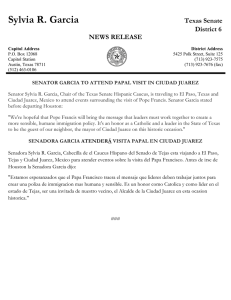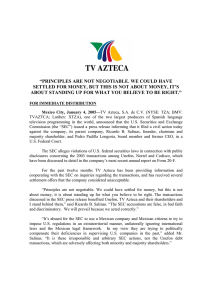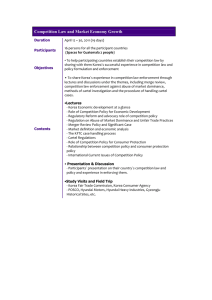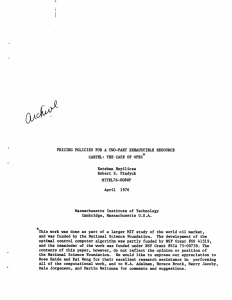Table of Contents
Anuncio
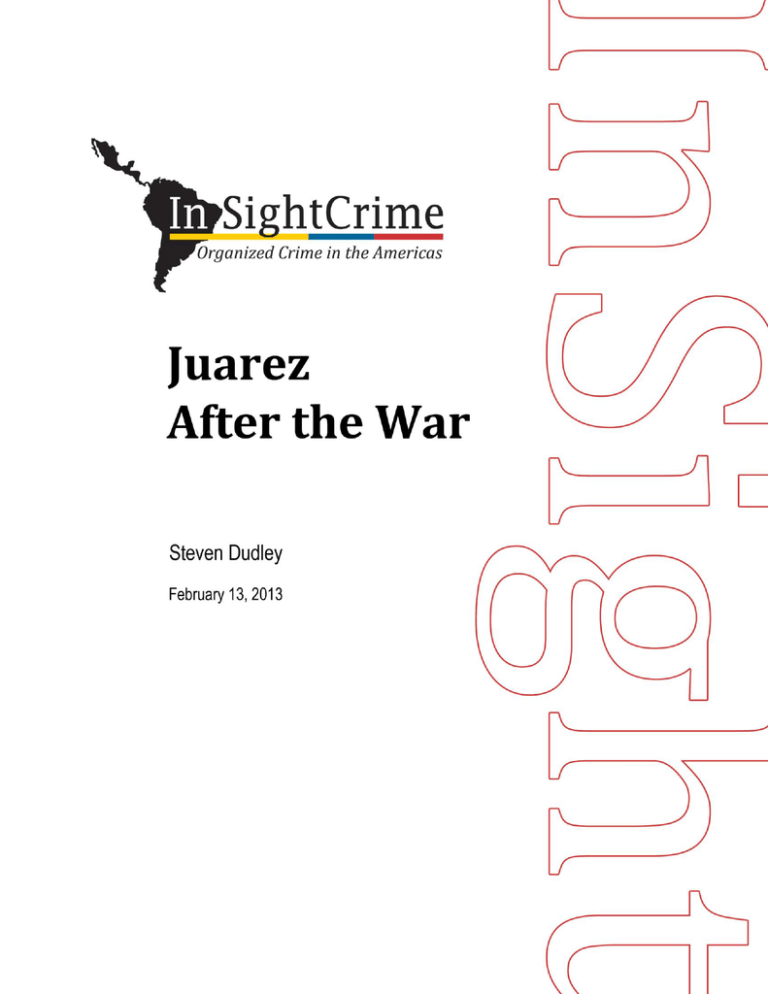
Table of Contents How Juarez's Police, Politicians Picked Winners of Gang War ............................... 3 Sinaloa versus Juarez ................................................................................................................... 3 The 'Guarantors' ............................................................................................................................ 4 First Fissures, then a Rupture....................................................................................................4 Towards a New Equilibrium? .....................................................................................................6 Barrio Azteca Gang Poised for Leap into International Drug Trade ..................... 7 Flying 'Kites' and Expanding to the 'Free World' .................................................................7 Barrio Azteca’s Juarez Operation ............................................................................................. 8 The New Barrio Azteca ................................................................................................................ 9 Barrio Azteca’s Modus Operandi .............................................................................................. 9 Becoming International Distributors? ................................................................................. 10 Police Use Brute Force to Break Crime’s Hold on Juarez ........................................ 12 Case Study: Victor Ramon Longoria Carrillo ...................................................................... 12 ‘Not Too Nice Yet’........................................................................................................................ 13 Ciudad Juarez: Mapping the Violence .......................................................................... 15 How Juarez's Police, Politicians Picked Winners of Gang War For many crime watchers, the fighting in Juarez that cost nearly 10,000 people their lives over a four year stretch was a battle of the titans: the Juarez Cartel versus the Sinaloa Cartel. But beneath that analysis is the deeper question of who pushes the levers of power in Mexico. The question is even more complicated in Juarez, a border city where several layers of power brokers are still seeking to impose their will on one another and control this lucrative plaza. These include large criminal groups, local and federal police, the army, the state Attorney General’s Office, politicians, and street gangs. Sinaloa versus Juarez As the story goes, beginning in early 2008, the Sinaloa Cartel corralled the Juarez Cartel in the city and then used a hit-and-run strategy to attack it within the city’s limits. After taking control of the larger drug trafficking corridors on the outskirts of the city, professional hitmen, going by the name “Gente Nueva,” or “New Arrivals,” chipped away at the Juarez Cartel’s money-making apparatus: the drug distribution centers and safehouses. Some empirical analysis seems to bear this out. A study by Carlos Vilalta and Robert Muggah that mapped the city’s most violent areas in 2009 and 2010 found a heavy concentration of homicides in poor areas where drug dens are prevalent. Having lost some of their main money-making centers, the increasingly desperate Juarez Cartel operatives turned to kidnapping and extortion to fund their battle. (Vilalta and Muggah’s study shows that “middle class” areas also came under fire.) This violence against the middle class pitted the locals against the Juarez Cartel and its operatives, making them easier targets for the authorities. Dozens of top-level Juarez operatives were killed or arrested. The Juarez Cartel leadership fled and splintered. The Sinaloa Cartel settled into positions of power, and has since imposed its will on the city. But this analysis falls short on two fronts. The first concerns violence amongst gangs in Juarez. The city has some 900 street gangs, many of whom serve as cannon fodder for international drug trafficking organizations, but many of whom remain as independent operators seeking to exploit the growing local drug market. In May 2010, at the height of the violence, police commander Facundo Rosas Rosas told InSight Crime that most of the fighting was between these gangs who were battling for the lower level “turf” -- part of which was related to the fight amongst the cartels, but part of which was not. Secondly, we must consider the role of state actors, namely politicians, prosecutors, police and military commanders -- the so-called “guarantors” of the underworld. The 'Guarantors' When the Sinaloa Cartel declared war on the Juarez Cartel in 2008, it did so by placing a banner on a monument to fallen police officers. The banner -- entitled “For those who did not believe” -- listed the names of four police officers who’d been assassinated. A section below that -- subtitled “For those who still don’t believe” -listed 17 more officers, who were still alive. All were supposedly members of La Linea, the Juarez Cartel’s armed wing. Police operatives were, in many ways, the guarantors of order in the city's underworld. For a price, they provided physical protection for personnel, illegal goods and services, and a modicum of assurance that no one would prosecute these personnel. Control them, and you controlled the underworld. Remove them, as began to happen from the very onset of the violence, and you had chaos. The traditional power broker, the Juarez Cartel, had established equilibrium in the city by paying these guarantors. It co-opted the local political class, such as mayors, city and state representatives, and the police: La Linea was drawn almost exclusively from active and retired police officers. It also rendered the Chihuahua Attorney General’s Office powerless, or worse, depending upon who you ask. For its part, the Sinaloa Cartel depended on different guarantors, namely members of the military and the federal police. (The most complete accounting of this tendency can be found in Anabel Hernandez’s “Los Señores del Narco”.) However, whether federal or local, these guarantors also have their own dynamics, their own leaders, their own inertia, and their own battles. There was, to be sure, a natural tension between these guarantors in Juarez. The ones at the top, the higherlevel politicians and political operatives, wanted to get paid more than the lowerlevel operatives. The lower echelons, namely the mid-level police commanders and investigators, naturally felt slighted. This tension may help explain why La Linea emerged in the first place. The group was in essence the police's way of guaranteeing that they would get their fair share. It's not a coincidence that other armed wings with ties to the security forces, such as the Zetas, emerged around the same time. Like La Linea, from the beginning they felt the need to have their own structure, name, and rules. That way they could ensure more return for their labor. First Fissures, then a Rupture There are many options to choose from when identifying the detonator for Juarez’s violence. For some, the battle dates back to 2004, when suspected Sinaloa operatives working for Joaquin “El Chapo” Guzman killed the Juarez Cartel leader, Rodolfo Carrillo Fuentes. The Juarez Cartel responded by killing Guzman’s brother. But that dispute seemed to subside, at least for a time, and members of both cartels continued to operate in the area. What’s more, La Linea appeared to be guaranteeing the business of both the Juarez Cartel and the Sinaloa Cartel, collecting what’s known as “piso,” or a toll, from both groups on merchandise traveling through the Juarez Valley. More fissures began to open in 2006, when a high level ex-police agent broke with the head of La Linea, alias “JL.” This began a scramble between the large organizations to gain control of as many guarantors as possible (see Sandra Rodriguez’s “La Fabrica del Crimen”). In this scramble, as another version goes, the Juarez Cartel started to overcompensate the top end of this structure, angering members at the lower end, thus adding to the fissures. At the same time, Juarez incorporated a new component; Barrio Azteca, a powerful street gang that controlled the prison system and street level distribution networks. This new actor tried to impose order on the old guard, establishing a clear accounting structure and military hierarchy. The Juarez Cartel also tried to monopolize control of the area and some of its new revenue streams, namely local drug distribution and extortion. The result of these various dynamics was an all-out rupture. Some members of La Linea aligned with the Sinaloa Cartel. The Sinaloa Cartel also incorporated pieces of the federal police and army into its scheme, and these forces provided an incredible boost for the group when they arrived in the city. The evidence regarding this alliance is anecdotal. However, when the military and the federal police arrived in 2008, violence levels were spiking; rather than calming the situation, the violence worsened while these two federal actors remained in Juarez. This period saw the mass incarceration of Aztecas and the capture of numerous high-level members of La Linea. The Juarez Cartel was able to hold the Sinaloa group at bay as long as it maintained some control over the upper echelon guarantors. But in the stretch between 2008 and 2011, the Juarez Cartel’s guarantors were in flux: the municipal and state police were purged, restocked and are now being purged to a lesser extent again; the municipal and state governments had elections and are filled with both recently elected and recently appointed officials; the state Attorney General’s Office has changed personnel at the top and middle management levels. The guarantors were also being targeted. As promised, the Sinaloa Cartel eliminated seven of the police listed on the banner who “still don’t believe.” The list’s other “executables” as they became know in Juarez, fled. Another 200 members of the police were killed during the violence, according to Sandra Rodriguez’s excellent account of this fight in her book, “La Fabrica del Crimen.” Sinaloa also attacked the upper levels, most notably the Attorney General’s Office and other judicial operatives, including Mario Angel Gonzalez, brother of state Attorney General Patricia Gonzalez. Mario Gonzalez was killed after being kidnapped and facing a videotaped interrogation, in which he admitted being part of La Linea. Patricia Gonzalez’s nephew was also killed in a mysterious incident. In the process the Juarez Cartel lost its leverage, and the tide shifted in Sinaloa's favor. By 2011, the die was cast and intelligence officials were calling Sinaloa the victor. Towards a New Equilibrium? The chaotic state of criminal organizations in Ciudad Juarez makes it difficult to determine whether the city is moving towards a new equilibrium, or drifting towards another phase of violence and re-accommodation. Recent statistics would suggest the former. Last year was the least violent 12-month stretch since 2007, with the state government registering 740 murders. Homicide levels are a fifth of what they were at the beginning of 2011. Naturally, some analysts and authorities have focused on the criminal groups to explain why homicides have dropped so quickly. The common sentiment is that the Sinaloa Cartel and its local operatives have established control over various key corridors in the city by buying off enough guarantors to dominate the plaza. Evidence of this, intelligence analysts and operatives say, is that the cartel is collecting “piso.” This is the levy placed on other organizations that use the territory to do business, most commonly passing illegal drugs through the area. Government intelligence officials told InSight Crime that they had recently captured members of the rival Familia Michoacana moving drugs through Juarez, and that when asked, the suspects said they were paying piso to the Sinaloa Cartel. But is this new equilibrium sustainable? The new order is not the same as the old. Sinaloa’s guarantors are now the ones in flux, which could leave them vulnerable to challenges from the rival Juarez Cartel, or even an upstart like the Aztecas. The military is no longer a presence, and the federal police are reducing their role. In addition, Sinaloa can no longer count on the traditional local guarantors either. Some remain in the pocket of the Juarez Cartel, which is still lurking and threatening to make a push back into the city. Others appear to be changing uniforms, literally. The municipal police, formerly the key guarantor for the Juarez, is now a wild card. Its chief, Julian Leyzaola, has illustrated unprecedented resolve. The state Attorney General’s Office is working in close collaboration with federal Mexican and US authorities and chipping away at what’s left of La Linea in the city. But the gains feel shaky, especially after a prolonged period of extreme violence. This violence exploded with such force -- going from around 300 murders per year to over 3,500 in 2010 -- that even the most optimistic of Juarez residents seem to be waiting for the next round of fighting to begin. Barrio Azteca Gang Poised for Leap into International Drug Trade Barrio Azteca, a prison gang born in the Texas jail system, is becoming a major player in the Mexican underworld and the "X-factor" in the battle for Ciudad Juarez, Mexican officials told InSight Crime. The group has as many as 5,000 members in the Juarez area alone. It works with the city’s multitude of smaller gangs, and has gained a more permanent role in the movement of drugs across the border since members of the traditional power broker family, the Carrillo Fuentes of the famed Juarez Cartel, vacated the area due to fighting with rivals in the Sinaloa Cartel. The battle scarred the city and shook the Mexican underworld. Its multilayered nature makes it difficult to decipher, even as its first phase appears to be receding in the rear view mirror. Ostensibly, the fight pitted the Juarez and the Sinaloa criminal organizations against each other. Juarez used its armed wing, La Linea, which is made up of current and former police officers. Sinaloa sent the so-called Gente Nueva, or “New Arrivals,” who are professional assassins, themselves plucked mostly from the ranks of the federal police and military. Both the Gente Nueva and La Linea drew foot soldiers from local gangs to fill out their units: the Mexicles and the Artistas Asesinos worked with the Gente Nueva; Barrio Azteca with La Linea. For the Juarez Cartel, Barrio Azteca was a fitting partner. Flying 'Kites' and Expanding to the 'Free World' Barrio Azteca started in 1986 in the El Paso jails, where it built a reputation as organized, disciplined, and fiercely loyal to its own. According to a 2011 US federal indictment filed against 35 Azteca members, the group refers to itself as “Familia Azteca” and demands that its members prioritize gang business over all other affairs. It enforces a set of “sacred rules” that establish hierarchies, means of ascension, and discipline for those who disobey. Punishments are meted out to members and their families alike. The federal indictment says that Barrio Azteca killed the stepdaughter of one member they believed was cooperating with law enforcement; the wife and parents of another suspected informant were also kidnapped and killed. Its tough image helped Barrio Azteca expand throughout the southwest and northeast. According to the FBI’s 2011 gang threat assessment, Barrio Azteca has cells in Massachusetts, Pennsylvania and Texas, and controls drug distribution in the border city of El Paso. Texas authorities say it operates in New Mexico as well, and has over 3,000 members in the United States. The leaders in jails communicate via official postal services and telephone, and use relatives and friends to pass coded messages called “kites” that relay orders to those in the “free world." Texas authorities say that Barrio Azteca was so effective that it worked as an extension of the Juarez Cartel. Its members “facilitate the movement of people and drugs in the United States; procure weapons, vehicles and other material for the cartel; and carry out acts of violence and other criminal activity on the cartel’s behalf,” the 2011 Texas Gang Threat Assessment said. Barrio Azteca operates on both sides of the border, but the leadership of the organization is in the US jails. The federal indictment quotes one member telling another in telephone conversation that the “money is made ‘south,’ but the power is in the United States.” Barrio Azteca’s Juarez Operation It’s not clear when the Barrio Azteca began operating in large numbers in Juarez. The group certainly expanded after 1996, when the United States changed immigration legislation and began deporting immigrant ex-cons en masse to places like Mexico. Like the Northern Triangle countries of Central America, Mexico received thousands of gang members who have strengthened their presence and extended their reach across borders. A former prison director in Chihuahua, Gustavo de la Rosa, said that Barrio Azteca had begun exerting control over the jails in that state with precision and discipline by the early 2000s. Azteca members have crew cuts, and must follow strict rules on drug consumption. This modus operandi impressed the local power brokers -- the Carrillo Fuentes Organization, aka the Juarez Cartel -- which began using the Aztecas as enforcers around the same time. During the war with the Sinaloa Cartel, which began in 2007, this role cost Barrio Azteca dearly: thousands died in the fighting in the years that followed, many of them Aztecas, intelligence officials told Insight Crime; top Barrio Azteca leaders were jailed or fled to other areas. Of the 35 indicted leaders named on the 2011 federal indictment, for instance, only two remain at large; 24 have pleaded guilty. In many ways, Barrio Azteca dug its own hole. It was responsible for killing 15 teenagers at a party in January 2010, an event that exploded in the Mexican government’s face when President Felipe Calderon suggested that the slain teens were connected to organized crime. This preceded a second massive federal troop buildup whose main target would be Barrio Azteca and the Juarez Cartel’s armed wing, La Linea, who many perceived as the most violent of the warring factions. On March 13, 2010, Aztecas members followed two vehicles with diplomatic plates leaving a birthday party, then ambushed them, killing a US consulate official, her spouse and the spouse of another consulate official. The incident ramped up US efforts and pressure on the Mexican government to go after Barrio Azteca in Juarez. But the Aztecas were also outwitted by their rivals. One Mexican intelligence official -- who, like the others in this story, requested anonymity because he is not authorized to speak to the media -- said there were several key distinguishing features that gave the Gente Nueva a tactical and operational edge. The group had more training and better weaponry; they were also more disciplined, using older model vehicles and refraining from nocturnal activities. The New Barrio Azteca The Aztecas appear to have learned some valuable lessons from the years of battles, and gained experience that may make them the strongest force in the region in the coming years. They now use older cars and better-trained units, Mexican intelligence officials said. Perhaps more importantly, they seem to be redefining their relationship with their former bosses. Vicente Carrillo Fuentes, the long-time leader of the Juarez Cartel, has absconded and may have retired. Other members of the family and criminal syndicate are said to be disputing his crown. Numerous members of La Linea have also been killed or arrested, and, along with the Carrillo Fuentes family, are thought to be hiding in the neighboring Sonora state. What's left of the structure in Juarez is the Aztecas. They occupy their traditional territory in the eastern neighborhoods, and control a portion of the southwestern edge of the city near the mountain range that juts from this mostly flat terrain, shows a map from Mexico's intelligence agencies obtained by InSight Crime. There they control the local drug distribution market, extortion, human smuggling and other smaller illegal businesses. They gained market share in some of these businesses during their time working with the Juarez Cartel, in a process that Southern Pulse calls “criminal technology transfer.” Their dominance, if not their presence, is total in these areas. Barrio Azteca’s Modus Operandi Juarez has an estimated 900 gangs operating ranging in size from 20 to the nearly 5,000 members of Barrio Azteca. The gangs in Aztecas-controlled areas operate under its purview, forming part of an elaborate and disciplined money-making system that resembles a well run local franchise. At the apex of Barrio Azteca are generals (known as “Capo Mayor” in the United States) who seek to control from the top down. They are older, between 45 and 50, and “lifers,” intelligence officials say. This is a small group: two or three in jail; five or six in the “free world.” They run the group by committee. All decisions must be made by consensus. No consensus means no action is taken. Below the generals are captains. These are the mid-level commanders who run the “mini-plazas” to generate revenue. They are beholden to the generals in every sense. Their main job in this scheme is to collect from the lieutenants and keep the financial books. The lieutenants, for their part, have numerous sergeants. These sergeants are a mix of Aztecas and non-Aztecas. They receive orders from the lieutenants who, depending on the area, request a fixed quota per week from these local underworld operators. The sergeants then employ the so-called "indios," or soldiers, to gather this revenue. As the revenue is passed upwards, each level takes its cut. The revenue streams are split into two large chunks. On the one hand is local drug distribution, which authorities estimate to represent a little more than half of the group's local revenue. On the other side is everything else: from extortion to human smuggling to car theft and weapons trafficking. The Aztecas’ revenue is significant, and they have developed ways to undermine police efforts to slow the pace of regeneration and growth. Most drug sales, for instance, are now delivered directly to the consumer. The orders are placed by phone using coded language that sounds like a fast food order: “pollo asado” (grilled chicken) means an order for cut cocaine; “pollo crudo” (raw chicken) is an order for pure cocaine to cook and resell as a derivative. The order is sent by numerous messengers in cars or on motorbikes and even bicycles. These "indios" are often underage and carry little more than a couple of doses, so if they are caught they will not be prosecuted. (Mexican law defines personal dosage as those carrying, for example, less than 5 grams of marijuana; it defines "intent to distribute" as carrying 1,000 times the amount of the personal dosage.) Those who are caught and prosecuted fall into a different sort of net: Mexico's jails. This may be where Barrio Azteca is at its best. In the Juarez jails, the Aztecas have a general, a military head and a public relations representative. On a visit, one government official recalled that Barrio Azteca’s public relations man, and not the jail's director, gave him the official tour. "The director [of the jail] said they had their own system," the official told InSight Crime. The visitor said the Aztecas area was clean and orderly. He contrasted it with the disorderly Mexicles/Artistas Asesinos patio, which he said was filthy and chaotic. The difference is critical, especially for the uninitiated. As the new inmates, their thoughts turn to self-preservation. The Aztecas offer the best option. After doing their time, these recruits return to the streets, now under strict orders of their Azteca generals, captains, lieutenants and sergeants. Membership is for life. Becoming International Distributors? The next step for Barrio Azteca is to consolidate its hold on the illegal drugs moving through Juarez. This may take time. The Sinaloa Cartel remains the dominant international trafficking network in the region. Barrio Azteca would have to seek to accommodate or displace that hefty rival if it were to play a larger role. Accommodation seems the more likely path at the moment. What’s more, the US side seems to only have experience moving smaller consignments. The 2011 federal indictment talks of 1 and 2 kilo packages of cocaine and heroin moving through the United States. But this may already be changing. In one case, the indictment says Barrio Azteca was moving 18 pounds of heroin to New York City. Barrio Azteca has infrastructure and personnel in place in the United States, and can use its large numbers and physical control of much of Juarez to demand an increasingly large share of the international drug trade. No other street gang is so close to making this leap. And the irony is that the battle for Juarez may have accelerated the process. Police Use Brute Force to Break Crime’s Hold on Juarez There appears to have been a security miracle in Ciudad Juarez, once one of the world's most violent cities. But while some applaud the city’s police chief, Julian Leyzaola, others fret about his near-systematic violation of human rights. Leyzaola’s arrival in March 2011 coincided with a dramatic drop in crime and homicide levels; the homicide rate is now one-fifth of what it was in that month. In November, the city had 27 murders, its lowest monthly number in nearly three years. The homicide rate, which reached an astounding 10 per day at one point, is down to about one per day. While this is still very high, the situation in Juarez now seems manageable. Other crimes, such as extortion, kidnapping and car theft, have also dropped precipitously. Complaints of extortion are one-third of what they were 18 months ago. Kidnapping is reportedly at one-quarter of what it was at its peak. In early 2011, there were two months with 540 incidents of violent car theft; in December, 2012, there were 56. Leyzaola, a retired lieutenant colonel, is all about confrontation. He has spent his tenure pushing police onto the streets, where they arrested anyone whom they saw as a threat. The numbers of arrests are as stunning as the crime statistics. In January 2011, the police arrested 1,462 people for suspected misdemeanors. In July 2012, that number was 13,568. Many of those detained pay fines for violations such as failure to carry proper identification. Others lose a half-day’s work. The result, say critics of Leyzaola, is that people are turning against the municipal government’s security plan. Case Study: Victor Ramon Longoria Carrillo One case illustrates the intensity and troubling nature of this policy. On February 17, 2012, the police arrived at the house of Victor Ramon Longoria Carrillo. Without a warrant, the police entered the house, shoved Victor into his room, covered his head with a sack, and beat him. “Where are the guns?” they asked. “Who do you work for?” Victor, his sister, his wife, and two of their neighbors later testified that the police eventually dragged Victor into a van and drove away, without telling the family where they were taking him. The family followed the police in their own car until a military caravan stopped them, and the police continued to the station, where Victor said the beatings continued. The police -- according to Leyzaola’s testimony to the Chihuahua State Human Rights Commission, which investigated the incident -- were following a lead from three suspects who’d car-jacked an H2-version Hummer earlier that day. The suspects said they’d stolen the car at the behest of their bosses, one of whom they identified as Victor. Two other alleged ringleaders were arrested along with Victor that same day. The men, the police said, had several AK-47s and munitions. One of them, they added, was alias “Kiko,” a local criminal leader, as El Diario’s account sets out. However, the commission found serious discrepancies in Leyzaola and the police’s story. To begin with, Victor’s house is nowhere near where the other two suspected leaders were arrested. The commission said Victor was arrested in his house, as he, his sister, his wife and the two neighbors testified. The commission added that the police had committed an illegal search and seizure at that house, and asked the municipal government to sanction the officers. ‘Not Too Nice Yet’ The police do not hide their aggressive stance. Leyzaola did not agree to an interview. But others in the police who spoke to InSight Crime said there was no hidden agenda. In fact, the police flaunt their aggressive tactics, calling them the “attack” (“choque”) phase. They believe that it can help them revive morale, belief in the institution, and respect from the populace and criminals alike. “The police cannot become too nice just yet,” one policeman, who was not authorized to speak on the record, told InSight Crime. “We are capturing killers. They don't think about human rights.” Juarez’s mayor, Hector Murguia, has the same attitude, reportedly telling people that he’ll leave before anyone gets rid of Leyzaola. The tricky debate of how to balance securing the city and protecting human rights often comes to a head at Juarez’s citizen-run security committee, known as the Mesa de Seguridad. The Mesa was formed after the brutal January 2010 massacre of 15 teens, who were mistaken by their killers for members of a rival gang. After the attack, President Felipe Calderon visited the city and met with civic and business leaders. Together they formed a series of working groups, or mesas, among them the Security Working Group, or Mesa de Seguridad. The members of the Mesa are not Juarez’s wealthiest. They are a mix of lawyers, doctors and businessmen. Some have security backgrounds. Most are citizens who decided to get involved as the security situation becomes dire for them, their relatives, their neighbors and their colleagues. Now they find themselves on the front lines. The Mesa has become an important broker for security issues. Citizens who have a problem and do not trust the authorities will often call someone from the Mesa, who will call a trusted member of the security or law enforcement community, who will act on the tip. The result can be immediate, as illustrated by the drop in complaints about extortion. To be sure, lowering extortion rates was at the center of the city’s security plan. Leyzaola did his part by passing out his personal phone number to shop owners in the city’s center. Those who called were surprised to get the lieutenant colonel himself on the phone. After speaking to the shop owner, Leyzaola would give his officers a description of the suspect or suspects who had collected or threatened to collect the weekly quota, and the officers would pick them up. Leyzaola would then get the shop owner back on the telephone, while the officers would drive the suspects up and down the street. When the squad car passed the shop, the owner would tell Leyzaola whether those were the bagmen or not. That way, the shop owners did not have to put themselves at risk. The municipal police is just one institution that has changed leaders. A new Chihuahua governor, Cesar Duarte, cleaned house at the state Attorney General’s Office, including replacing its head, Patricia Gonzalez. Gonzalez was linked in press accounts to the Juarez Cartel, for which her brother was assassinated by suspected members of the Sinaloa Cartel. The most cynical observers say security gains in the city have come about because the Sinaloa Cartel has become the dominant player in the area. This may be, in part, true. But it is also shortsighted and places too much emphasis on the criminals rather than government actors. Indeed, several security officials, who spoke to InSight Crime on condition their names or institutional affiliations were not revealed, said the various Mexican security and law enforcement bodies were working together better than ever. They added they were sharing more information with their US counterparts, who provided real-time intelligence, allowing Mexican authorities to arrest high-level suspects. The Chihuahua and Juarez police are also restocking their ranks with new recruits and getting training from the United States. But the process is slow and illustrates just how fragile the security gains are. The Juarez police recently graduated its first class of recruits since Leyzaola’s arrival. Of the 3,000 applicants, 100 passed the battery of obligatory mental aptitude, psychological and polygraph tests. Of those, 81 made it through basic training. Ciudad Juarez: Mapping the Violence Juarez has always been a volatile place. It is a border city that draws huge numbers of migrants seeking work, and engenders large discrepancies between its wealthiest and poorest residents -- all factors associated with violence. However, mapping this phenomenon does not necessarily yield the expected results. A recent study by two prominent social scientists funded by the HASOW initiative at PUC - Rio noted that violence in Juarez in 2009-2010 was concentrated in certain sectors of the city, as expected, but did not always follow the expected pattern in terms of the socio-economic status of the victims. Using government-furnished data, the researchers, Robert Muggah of Igarape (Brazil) and Carlos Vilalta of CIDE (Mexico), found that violent incidents were centered in the northwest and southwest quadrants, specifically three areas of the city known as Delicias, Aldama and Babicora Sur. They then determined whether six specific “risk factors” were present in these areas. These risk factors were based on what is known as social disorganization theory, which seeks to explain criminal behavior by “focusing on the compositional and contextual characteristics of specific settings.” According to this theory, there are numerous factors that lead to higher rates of violence, such as size of the immigrant population, education and poverty rates. Of these factors, the researchers found that “population from another state” was the one that most correlated to these violent areas. In Juarez -- a border town where much of the population has come from other areas in search of work in the “maquila” industry -- this is not surprising. What was surprising was that the more educated areas corresponded to the highest rates of violence. Although it bears mentioning that “educated” is defined as a 9th grade education in Mexico, the researchers seem confounded by this result; as they say, more research is needed. “It is difficult to interpret this finding in the absence of more information on the perpetrators,” they write. Equally baffling was the high rate of violence in areas where “social welfare” programs were strong. Specifically, the researchers used the social security benefits for state workers to illustrate that violence corresponded to ostensibly “middle class” districts. Finally, there is a discrepancy with regards to the poor areas. The researchers had two tiers of poor: one in which there is “no access to water” and “vacant housing”; and one in which there are “occupied housing units with no cemented floors.” The former (i.e., slightly richer) corresponded to more violent areas. The overall takeaway from this study is difficult to discern, but the obvious preliminary conclusion is alarming: violence took place in largely middle class areas in Juarez. The reasons for this, as the authors themselves say, are harder to decipher. “Such unique events probably demand a wider study beyond demographic and socioeconomic composition variables,” they write. *Research for this report was paid for, in part, by the National Institute for Justice and the Woodrow Wilson Center for International Scholars. The author’s assertions do not, in any way, reflect either institution’s positions on matters of security in Mexico or Ciudad Juarez.
